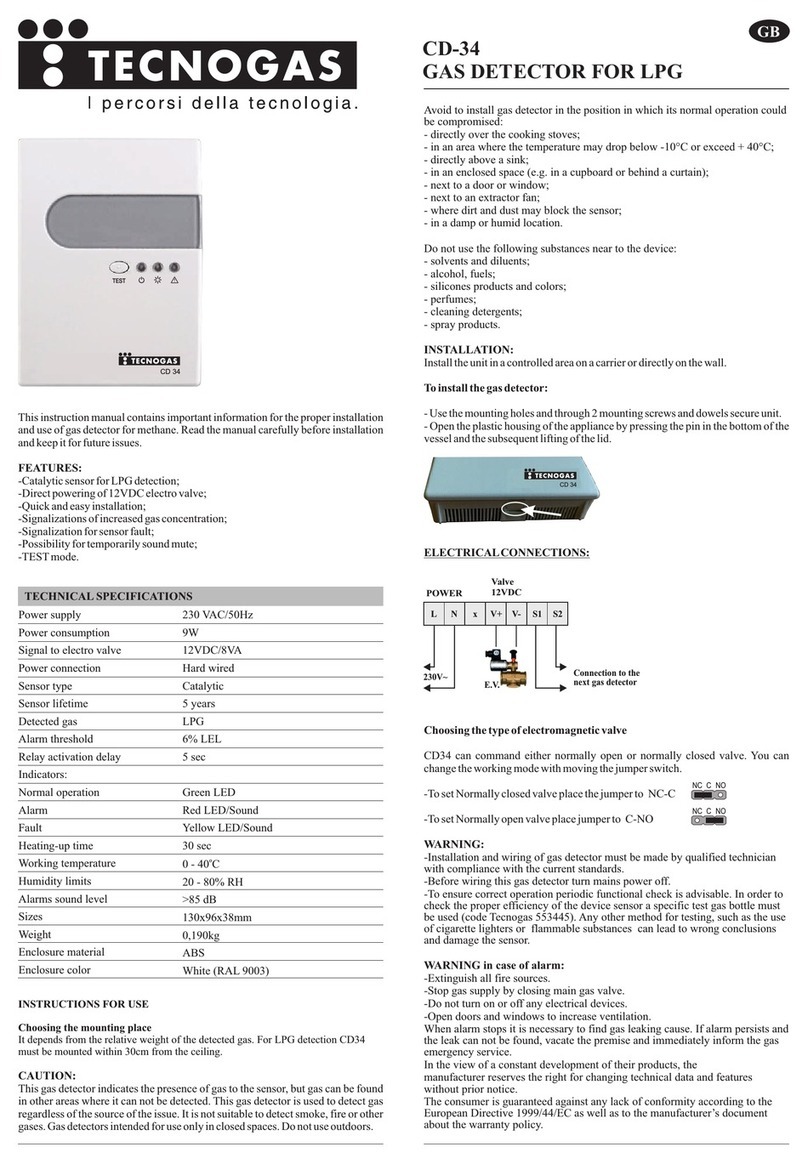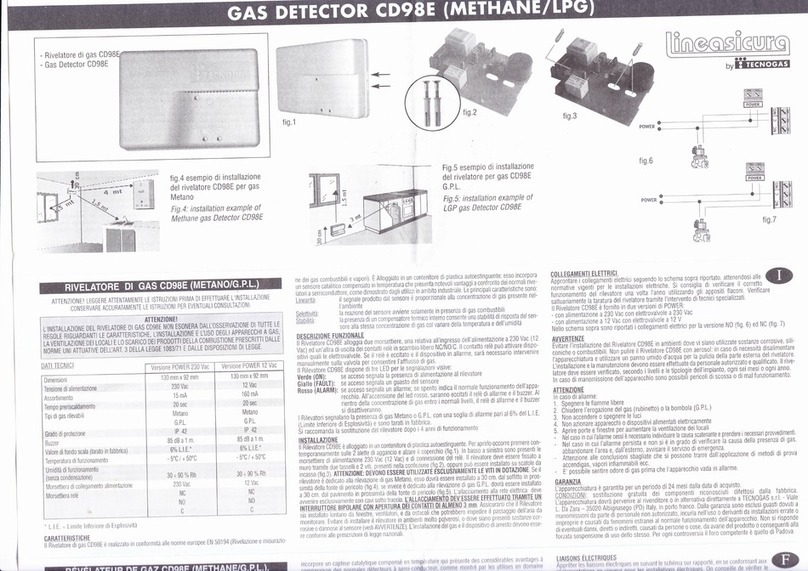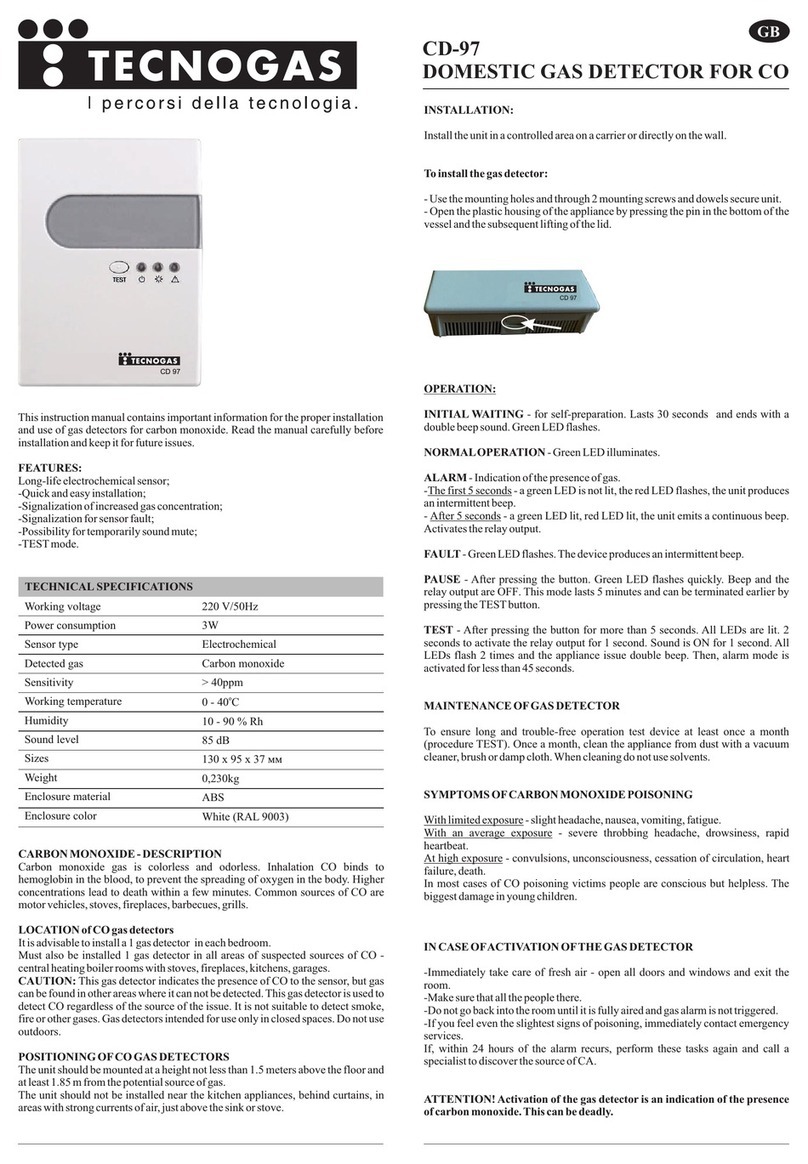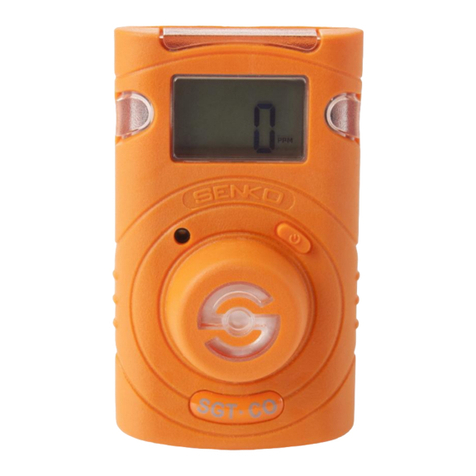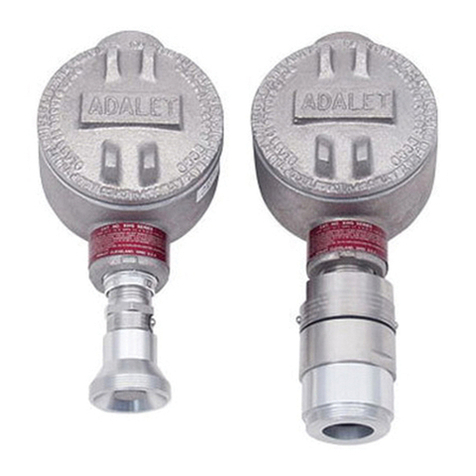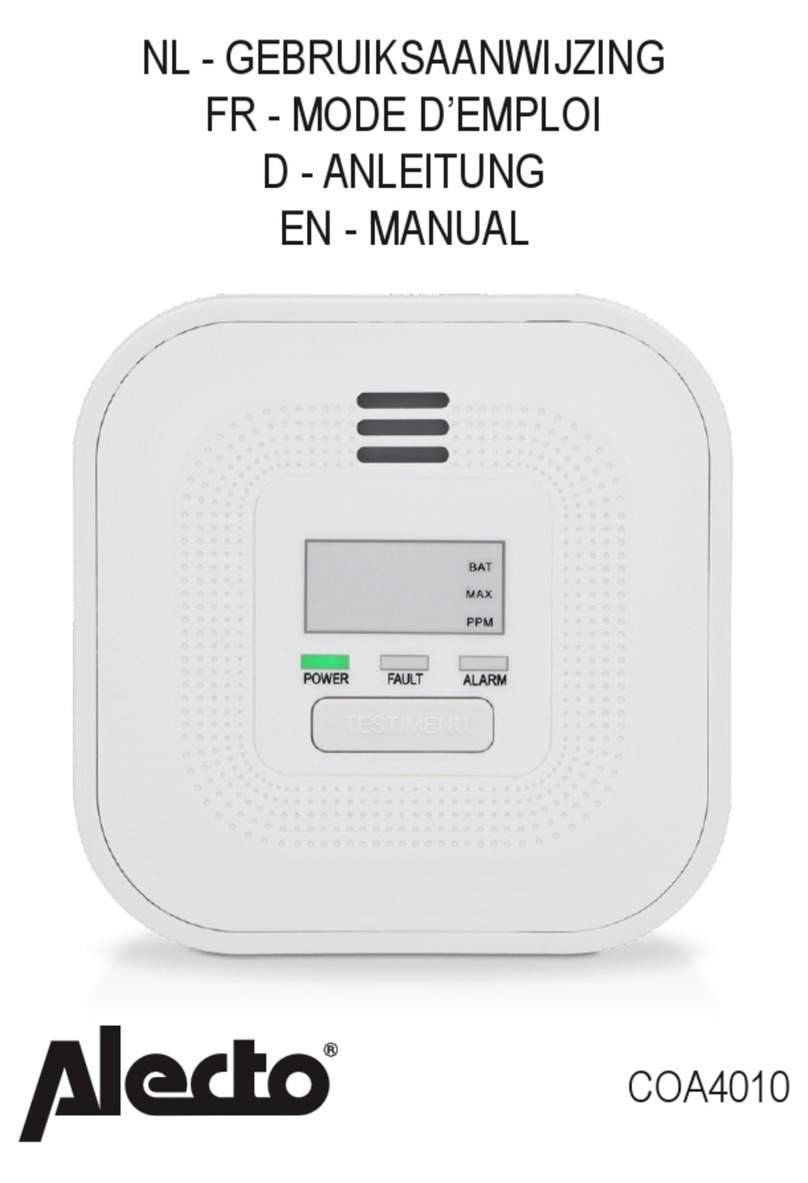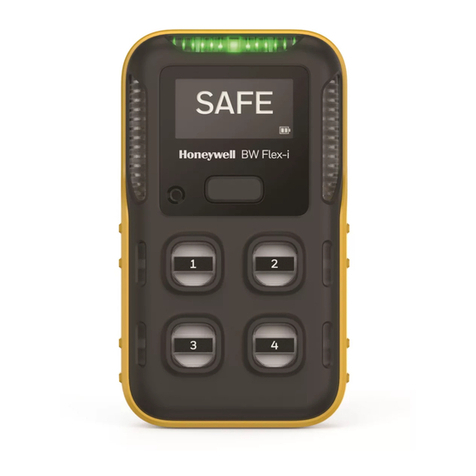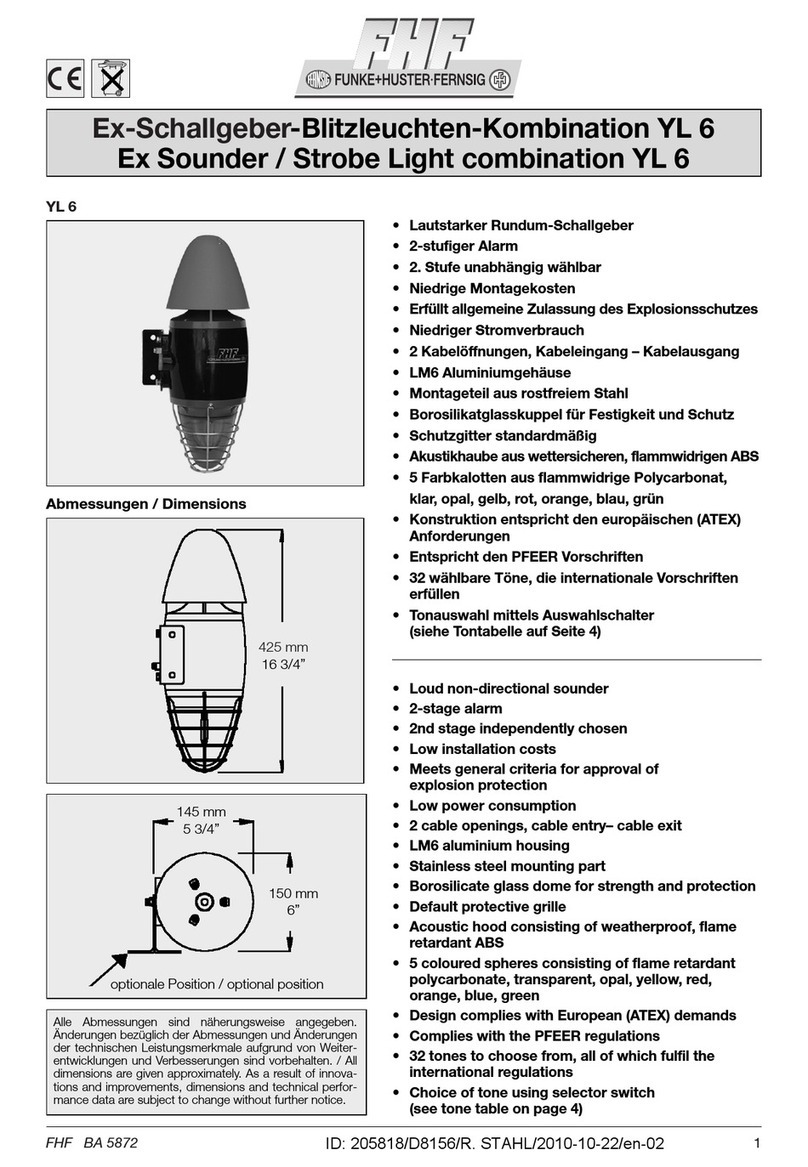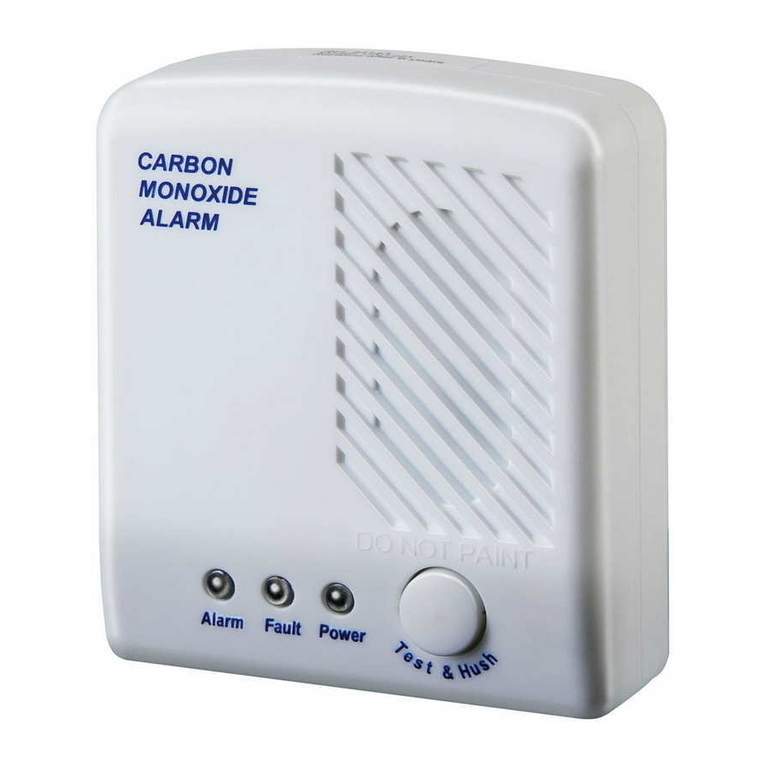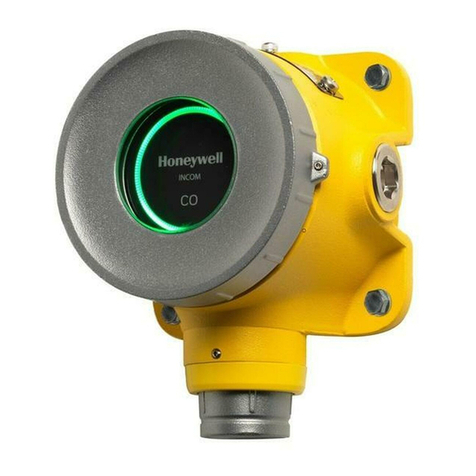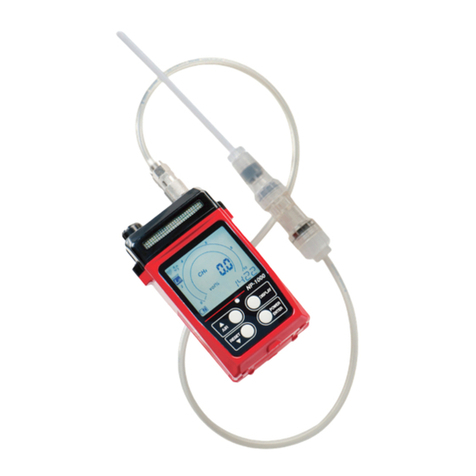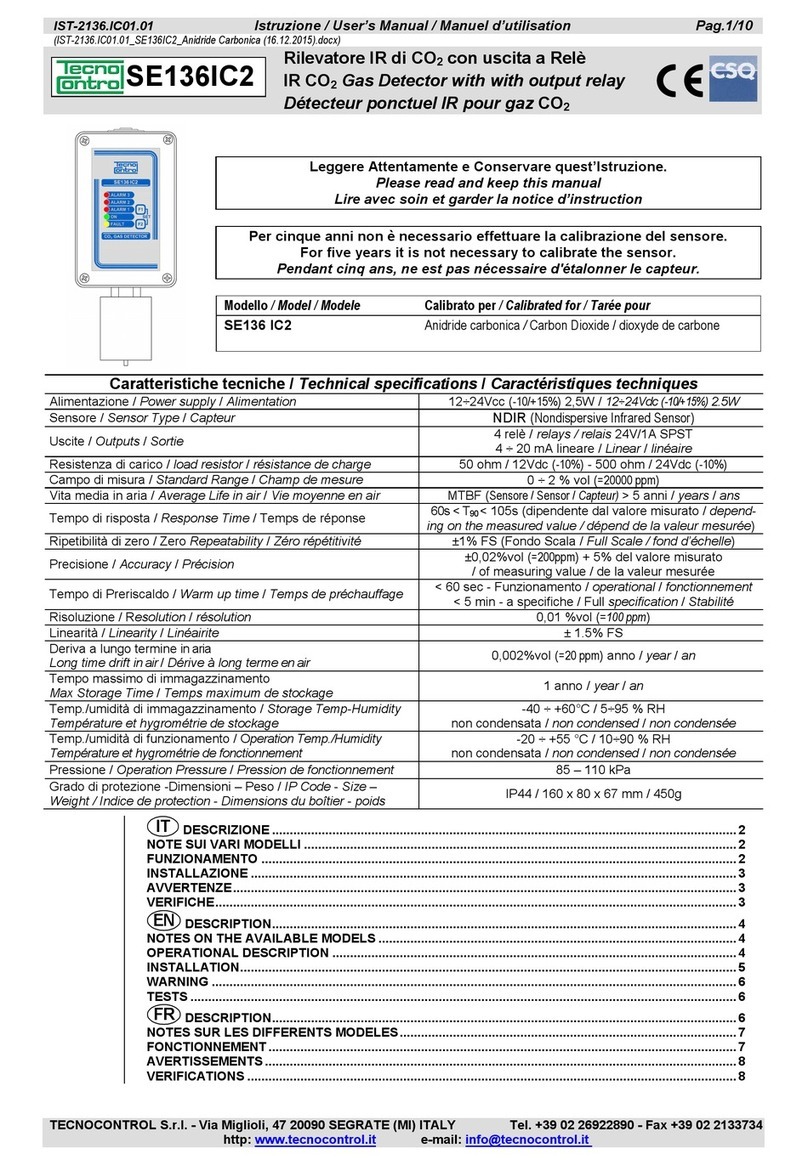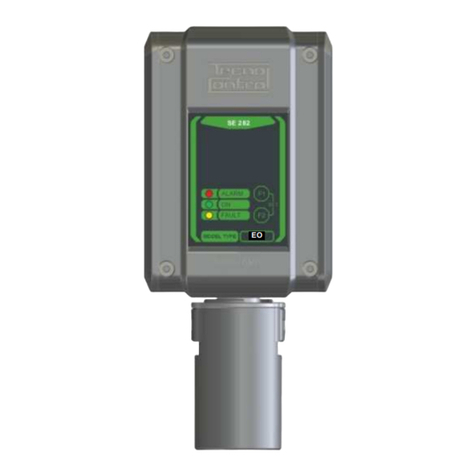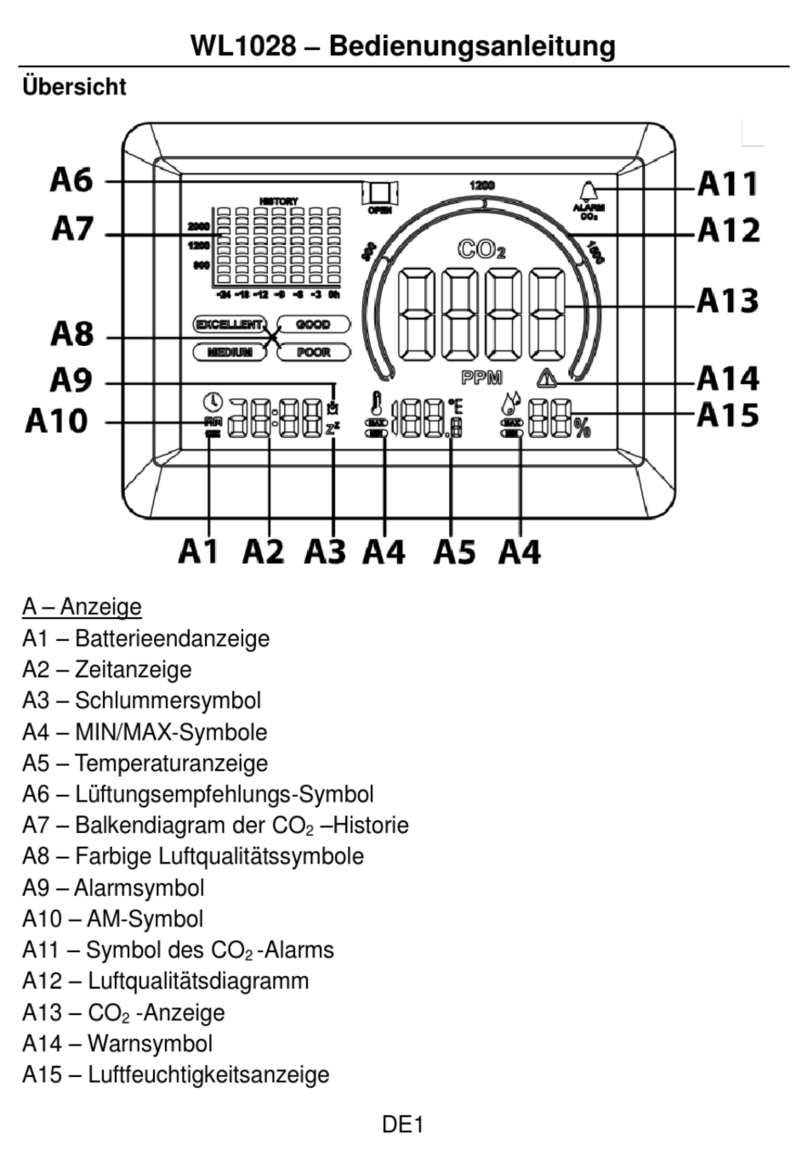Tecnogas CD-99 User manual

Working voltage
Power consumption
Methane gas sensor
Methane alarm threshold
Carbon monoxide sensor
CO measuring range
Detected gas
Sensitivity
Working temperature
Sound level
Sizes
Weight
Enclosure material
Enclosure color
220 V/50Hz
3W
Catalytic
10%LEL
Electrochemical
Carbon monoxide
30 - 300ppm
> 40ppm
о
0 - 40 С
85 dB
130 х 95 х 37 мм
0,230kg
ABS
White (RAL 9003)
This instruction manual contains important information for the proper installation
and use of gas detector for methane and carbon monoxide. Read the manual
carefully before installation and keep it for future issues.
FEATURES:
-Long life electrochemical sensor for CO;
-Catalytic sensor for CH detection
-Quick and easy installation;
-Signalizations of increased gas concentration;
-Signalization for sensor fault;
-Possibility for temporarily sound mute;
-TEST mode.
TECHNICAL SPECIFICATIONS
CARBON MONOXIDE - DESCRIPTION
Carbon monoxide gas is colorless and odorless. Inhalation CO binds to
hemoglobin in the blood, to prevent the spreading of oxygen in the body. Higher
concentrations lead to death within a few minutes. Common sources of CO are
motor vehicles, stoves, fireplaces, barbecues, grills.
LOCATION AND POSITIONING OF THE GAS DETECTOR
It is advisable to install a 1 gas detector in each bedroom. Must also be installed 1
gas detector in all areas of suspected sources of CO - central heating boiler rooms
with stoves, fireplaces, kitchens, garages. The unit should be mounted at a height
not less than 1.5 meters above the floor and no higher than 30cm from the highest
point of ceiling. The unit should not be installed near the kitchen appliances,
behind curtains, in areas with strong currents of air, just above the sink or stove.
CAUTION: This gas detector indicates the presence of gas to the sensor, but gas
can be found in other areas where it can not be detected. This gas detector is used to
detect gas regardless of the source of the issue. It is not suitable to detect smoke,
fire or other gases. Gas detectors intended for use only in closed spaces. Do not use
outdoors.
INSTALLATION:
Install the unit in a controlled area on a carrier or directly on the wall.
To install the gas detector:
- Use the mounting holes and through 2 mounting screws and dowels secure unit.
- Open the plastic housing of the appliance by pressing the pin in the bottom of the
vessel and the subsequent lifting of the lid.
ELECTRICAL CONNECTIONS:
OPERATION:
INITIAL WAITING - self-preparation. Lasts 60 seconds.Green LED flashes.
NORMAL OPERATION - Green LED illuminates.
ALARM-CH4 - Indication of the presence of CH4 gas. Green LED illuminates.
The first 5 seconds red LED-CH4 flashes. After 5 seconds - red LED-CH4 lit
permanently,the unit emits a continuous sound and activates the CH4 relay output.
ALARM-CO - Indication of the presence of CO gas. Green LED illuminates. The
first 5 seconds red LED-CO flashes. After 5 seconds red LED-CO lit permanently,
the unit emits a intermittent sound and activates the CO relay output.
ALARM-CH4+CO - Indication of the presence of CH4 and CO gas. Green LED
illuminates. The red LED-CH4 and LED-CO lit, the unit emits consistently
interrupted and continuous sound. Both CH4 and CO relays are activated.
CH4 SENSOR FAULT - yellow LED is blinking. Red LED-CH4 is blinking. The
device produces short sound signals.
CO SENSOR FAULT - yellow LED is blinking. Red LED-CO is blinking. The
device produces short sound signals.
PAUSE - After pressing the button. Green LED flashes. Sound and relays output
are OFF. This mode lasts 5 minutes and can be terminated earlier by pressing the
TEST button.
TEST - Press and hold the button till the specific sound is heard. The instrument
makes self test that lasts 20seconds and automatically enters NORMAL
OPERATION mode.
MAINTENANCE OF GAS DETECTOR
To ensure long and trouble-free operation test device at least once a month
(procedure TEST). Once a month, clean the appliance from dust with a vacuum
cleaner, brush or damp cloth. When cleaning do not use solvents.
SYMPTOMS OF CARBON MONOXIDE POISONING
With limited exposure - slight headache, nausea, vomiting, fatigue.
With an average exposure - severe throbbing headache, drowsiness, rapid
heartbeat.
At high exposure - convulsions, unconsciousness, cessation of circulation, heart
failure, death.
In most cases of CO poisoning victims people are conscious but helpless. The
biggest damage in young children.
IN CASE OF ACTIVATION OF THE GAS DETECTOR
-Immediately take care of fresh air - open all doors and windows and exit the
room.
-Make sure that all the people there.
-Do not go back into the room until it is fully aired and gas alarm is not triggered.
-If you feel even the slightest signs of poisoning, immediately contact emergency
services.
If, within 24 hours of the alarm recurs, perform these tasks again and call a
specialist to discover the source of CA.
ATTENTION! Activation of the gas detector is an indication of the presence
of carbon monoxide or methane. This can be deadly.
CD-99
DOUBLE GAS DETECTOR CH4+CO
GB
CD 99
CD 99
L N
CO CH4
N.O.
E.V.
220V~
Fan
1 2 3 4 5 6 7 8
CH4 CO

Tensione
Consumo
Sensore CH4
Soglia allarme metano
Sensore CO
Gas rilevato
Sensibilità
Temperatura di esercizio
Livello sonoro
Dimensioni
Peso
Materiale involucro
Colore involucro
220V/50Hz
3W
Catalitico
10%LIE
Elettrochimico
30-300ppm
> 40ppm
0 – 40°C
85 dB
130 x 95 x 37 mm
0,23 kg.
ABS
Bianco RAL 9003
FOGLIO ISTRUZIONI
Questo foglio d'istruzioni contiene informazioni importanti per una corretta
installazione e utilizzo dei rivelatori per metano e monossido di carbonio. Leggere
il foglio attentamente prima dell'installazione e conservarlo in caso di necessità
future.
CARATTERISTICHE:
-Sensore elettrochimico a lunga durata per CO
-Sensore catalitico per CH4
-Installazione semplice e veloce
-Segnalazione della concentrazione di gas
-Segnalazione malfunzionamento sensore
-Funzione spegnimento temporaneo cicalino
-Funzione TEST
SPECIFICHE TECNICHE
DESCRIZIONE MONOSSIDO CARBONIO
Il monossido di carbonio è una sostanza incolore e inodore. L'inalazione del CO
blocca l'emoglobina nel sangue e quindi l'afflusso di ossigeno all'organismo. Alte
concentrazioni di CO portano alla morte in pochi minuti. Fonti comuni di CO sono
i veicoli a motore, le caldaie, i fornelli, i camini, i barbecue, le sigarette.
PRECAUZIONI
Il rivelatore indica la presenza di CO e CH4 in prossimità del rivelatore stesso.
Non è adatto come rivelatore fumi o incendio e deve essere installato solamente in
ambienti chiusi.
L'intervento del rivelatore CO e CH4 indica la presenza di monossido di carbonio
e metano che possono essere letali.
In caso di attivazione del rivelatore, arieggiare immediatamente l'ambiente
aprendo porte e finestre, uscire dall'ambiente e non rientrare finché l'allarme non
cessa, contattare eventualmente il pronto soccorso. Verificare attentamente in
seguito il motivo di intervento del rivelatore
INSTALLAZIONE DEL RIVELATORE
E' consigliabile installare il rivelatore vicino alle fonti che possono rilasciare CO e
in ogni stanza da letto. Deve essere installato a parete a un'altezza non inferiore a
1,5 m dal pavimento e a 30 cm dal soffito. Non deve essere installato vicino agli
elettrodomestici, dietro alle tende, in luoghi con forti correnti d'aria.
Per installare il rivelatore, aprire l'involucro premendo e sollevando il coperchio
come indicato in figura e usare le viti a corredo per installarlo a parete.
SCHEMA ELETTRICO
FUNZIONAMENTO
INIZIALIZZAZIONE: dura 60 secondi, il led verde lampeggia.
NORMALE FUNZIONAMENTO: led verde acceso.
ALLARME Ch4: indica presenza di CH4, nei primi 5 secondi il led rosso
lampeggia, e dopo 5 secondi resta acceso. Il rivelatore produce un cicalino
continuo e attiva l'uscita relè Ch4.
ALLARME CO: indica la presenza di CO, nei primi 5 secondi lampeggia il Led
CO e dopo 5 secondi resta acceso. Il rivelatore emette un cicalino intermittente e
attiva l'uscita relè CO.
ALLARME CH4+CO: indica la presenza di CH4 e CO, i led CH4 e CO si
accendono e il rivelatore emette un cicalino intermittente e continuo e attiva
entrambe le uscite relè CH4 e CO.
DIFETTO SENSORE CH4: il led giallo e rosso si accendono, il rilevatore
emette un breve segnale sonoro.
DIFETTO SENSORE CO: il led giallo e rosso si accendono, il rilevatore
emette un breve segnale sonoro.
PAUSA: premere il tasto reset, il led verde lampeggia velocemente, cicalino e
uscita relè si disattivano. Questa modalità termina dopo 5 minuti oppure
premendo nuovamente il tasto reset
TEST: tenere premuto il tasto test fino a all'emissione di un segnale acustico, il
rivelatore esegue un auto test che dura 20 secondi e di seguito inizia il normale
funzionamento.
MANUTENZIONE
Per assicurare una lunga durata al rivelatore, pulire con un panno il rivelatore ed
eseguire la procedura TEST almeno una volta al mese
SINTOMI DI AVVELENAMENTO DA MONOSSIDO DI CARBONIO
Esposizione limitata: mal di testa, nausea, vomito, senso di affaticamento
Esposizione media: forte mal di testa, svenimento, attacco cardiaco
Esposizione lunga: convulsioni, stato d'incoscienza, blocco della circolazione
sanguigna e del cuore, morte
CD-99
RIVELATORE DOMESTICO CO e CH4
IT
CD 99
CD 99
L N
CO CH4
N.O.
E.V.
220V~
Fan
1 2 3 4 5 6 7 8
CH4 CO
Table of contents
Languages:
Other Tecnogas Gas Detector manuals
Popular Gas Detector manuals by other brands
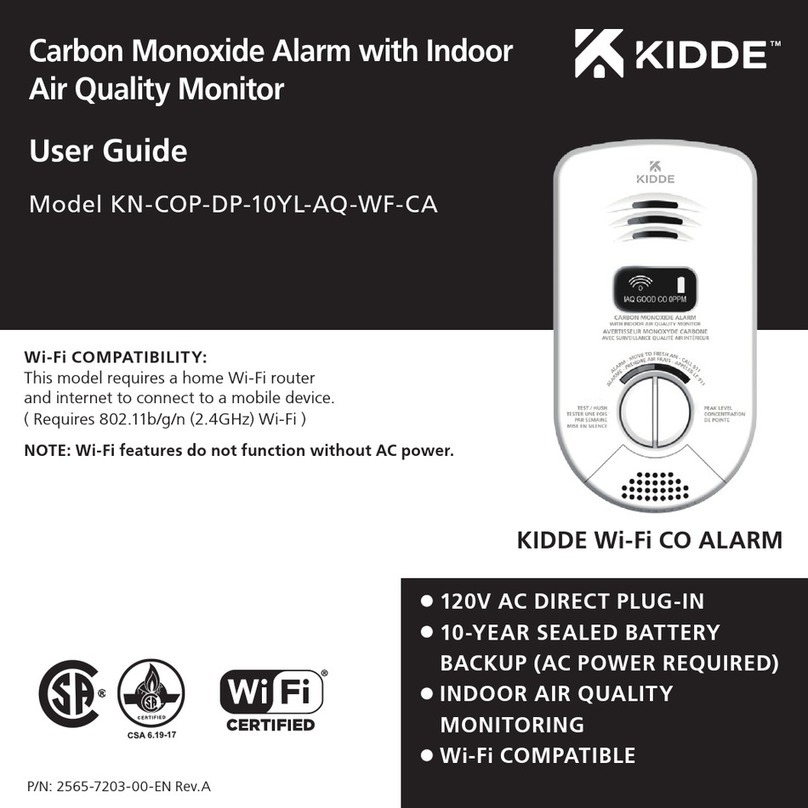
Kidde
Kidde KN-COP-DP-10YL-AQ-WF-CA user guide

Elektrotechnik Elektronik
Elektrotechnik Elektronik GX-A1+ operating instructions
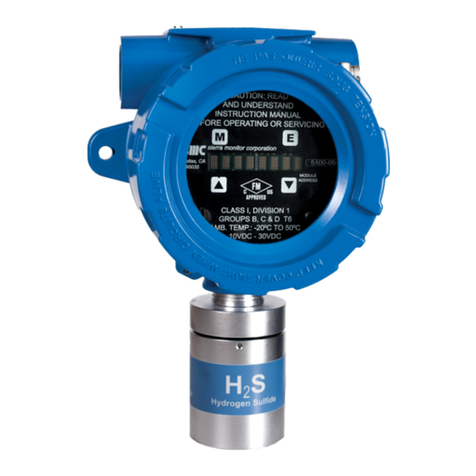
MSA
MSA SMC 5100-IT Series operating manual
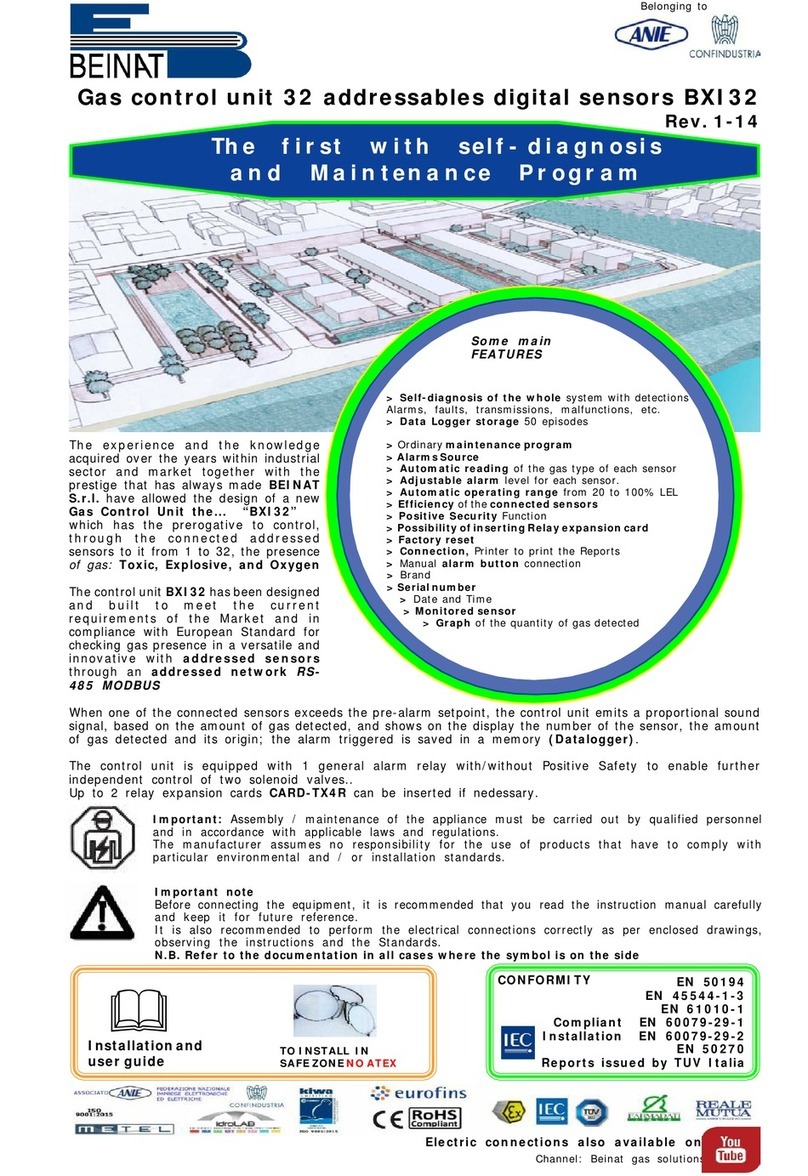
BEINAT
BEINAT BXI32 Installation and user guide
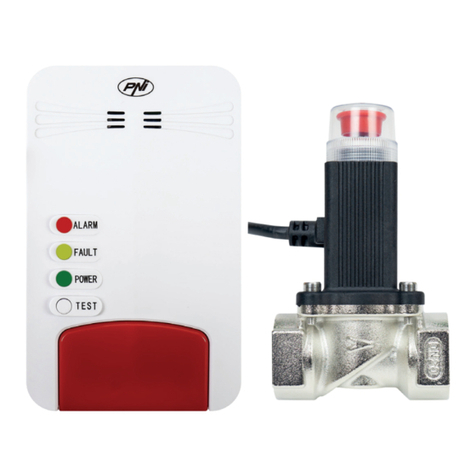
PNI
PNI Safe House Smart Gas 300 WiFi user manual

Sensitron
Sensitron PL4 +D Manual for installation and use

